Exercises (3159)
Knee lift from lunge (right) with extension and flexion of the arms (chest press) ► lunge & knee lift with chest press
Power
Individual work
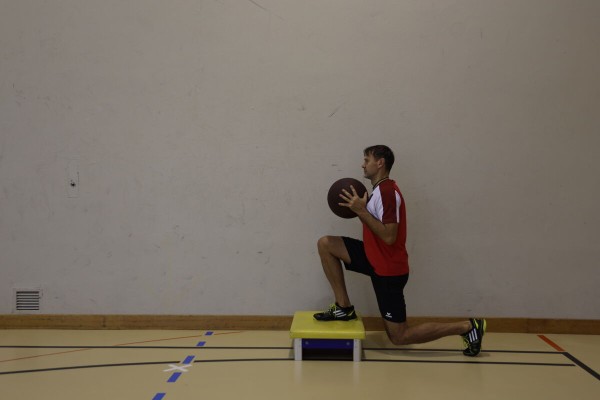
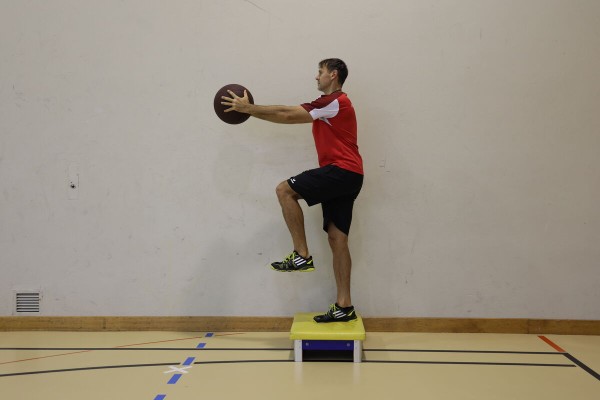
Lunge, with the front (right) leg placed at a right angle in the knee joint on a small raised surface (e.g. weight disc) and the back (left) leg placed on the floor on tiptoe only, with the thigh and lower leg also at approximately a 90 degree angle. The bent arms hold a medicine ball in front of the chest. From this position, straighten the front leg and simultaneously push the back leg off the floor and bend the knee in a fluid movement to reach a one-legged stance on the raised surface. Whilst performing the movement, stretch your arms out in a holding position (arms horizontal to the floor). Then bring the bent knee back to a high holding position and place it on the floor and bend the supporting leg to return to the starting position in a lunge. The arms are also bent back to the starting position.
Attention:
Always keep the front knee behind the toe and centred over the foot, upper body upright and abdomen tensed.
Lighten:
Lift the knees less, lower the upper body less (greater angle in the knees); without additional weight (medicine ball).
Harden:
Higher base; additional weight (on the foot); perform a small one-legged jump on the raised base.
1 weight disc
1 medicine ball
1 long bench/swinging box ► Make the exercise more difficult (position)
1 weight cuff ► Make the exercise more difficult (additional weight)
Knee lift from lunge (right) with extension and flexion of the arm (shoulder press) ► lunge & knee lift with shoulder press
Power
Individual work
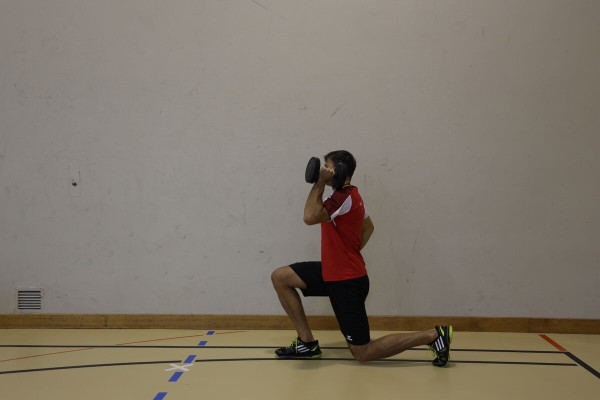
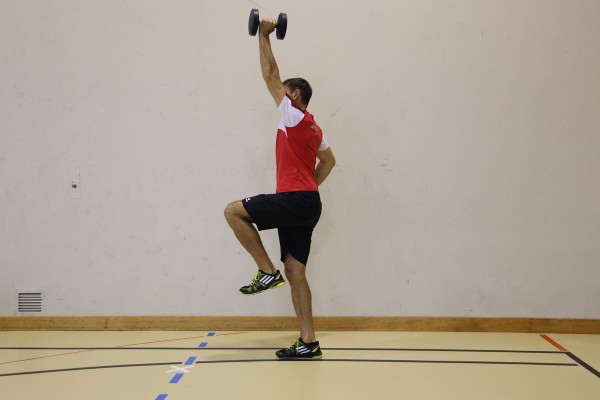
Lunge, the front (right) leg is placed on the floor with a right angle at the knee joint, the back (left) leg is placed on the floor on tiptoe only, with the thigh and lower leg also at approximately a 90 degree angle. One arm (right) is supported on the hip, the left arm is bent and holding the weight in the hand (dumbbell or kettlebell) so that the weight is next to the head at ear level. From this position, straighten the front leg and simultaneously push the back leg off the floor and bend the knee in a fluid movement to reach a one-legged stance. While performing the movement, push the bent arm with the weight in your hand vertically upwards (hold your arm up). The other arm remains supported on the hip. Then move the bent knee backwards in the hold-up position and place it on the floor and bend the supporting leg to return to the starting position in the lunge. The playing arm is also bent back to the starting position.
Attention:
Always keep the front knee behind the tip of the foot and centred over the foot, upper body upright and abdomen tensed.
Lighten:
Lift the knees less, lower the upper body less (greater angle in the knees); without additional weight (dumbbell or kettlebell).
Harden:
Raise the (front) supporting leg; additional weight (on the back foot); perform a small one-legged jump.
1 dumbbell/kettlebell
1 weight disc/long bench/swinging box ► Make the exercise more difficult (position)
1 weight cuff ► Make the exercise more difficult (additional weight)
Lifting the knee and jumping in place from the lunge (left) ► lunge hop
Power
Individual work
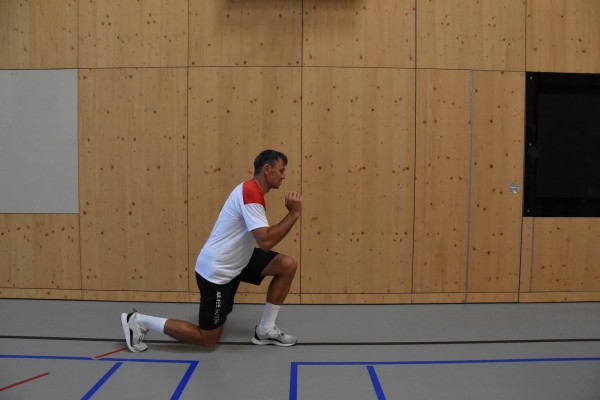

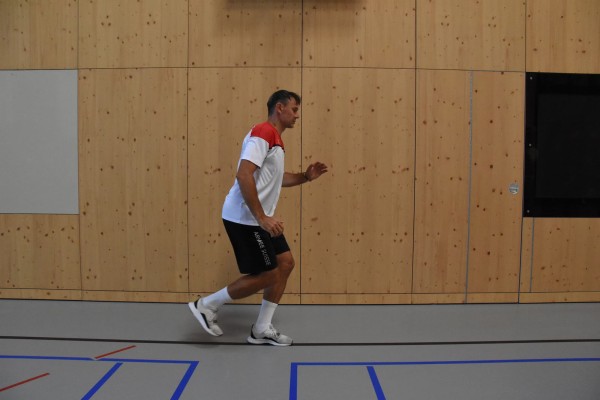

Lunge, the front (left) leg is placed on the floor with a right angle at the knee joint, the back (right) leg is placed on the floor on tiptoe only, with the thigh and lower leg also at approximately a 90 degree angle. The left arm on the body points diagonally downwards at the back, the right arm is bent (hold the hand approximately at ear level). From this position, stretch the front leg and perform a small (one-legged) jump in place. At the same time, push the back leg off the floor and bend the knee in a fluid movement so that the knee is approximately at hip height. Change the position of the arms during the movement. Land on the jumping leg, bringing the free leg directly back to the starting position. The arms are also moved back to the starting position at the same time.
Attention:
Always keep the front knee behind the tip of the foot and centred over the foot, upper body upright and stomach tensed.
Lighten:
Lift the knee without jumping.
Harden:
Additional weight (on the chest/shoulders, hold in the hands, hold in front).
2 weight cuffs/short dumbbells/1 weight vest/weight disc/(medicine) ball/sandbag/fighting backpack ► Make the exercise more difficult (additional weight)
Lifting the knee and jumping in place from the lunge (right) ► lunge hop
Power
Individual work
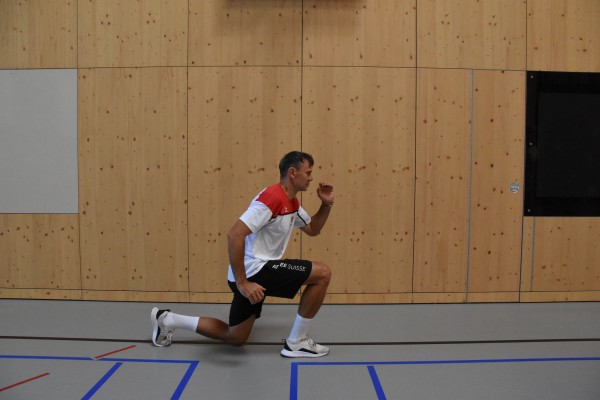
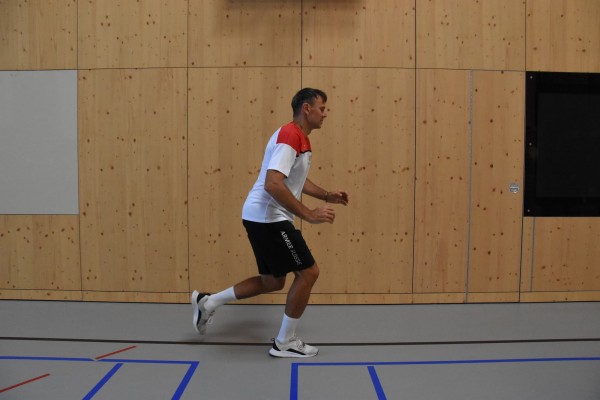
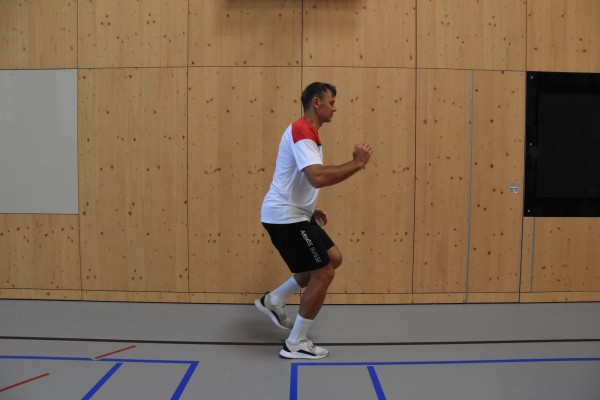
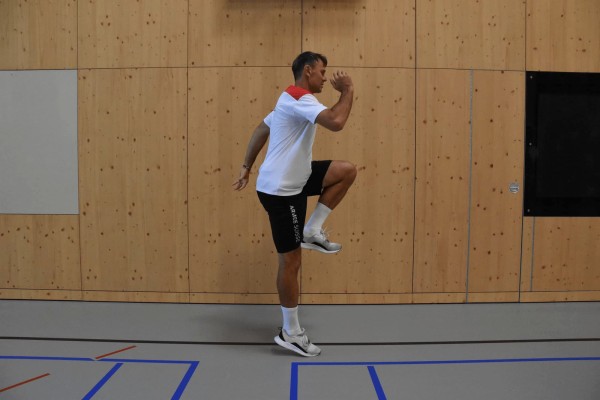
Lunge, the front (right) leg is placed on the floor with a right angle at the knee joint, the back (left) leg is placed on the floor on tiptoe only, with the thigh and lower leg also at approximately a 90 degree angle. The left arm on the body points diagonally downwards at the back, the right arm is bent (hold the hand approximately at ear level). From this position, stretch the front leg and perform a small (one-legged) jump in place. At the same time, push the back leg off the floor and bend the knee in a fluid movement so that the knee is approximately at hip height. Change the position of the arms during the movement. Land on the jumping leg, bringing the free leg directly back to the starting position. The arms are also moved back to the starting position at the same time.
Attention:
Always keep the front knee behind the tip of the foot and centred over the foot, upper body upright and stomach tensed.
Lighten:
Lift the knee without jumping.
Harden:
Additional weight (on the chest/shoulders, hold in the hands, hold in front).
2 weight cuffs/short dumbbells/1 weight vest/weight disc/(medicine) ball/sandbag/fighting backpack ► Make the exercise more difficult (additional weight)
Lifting the body out of the seat with the arms
Power
Individual work

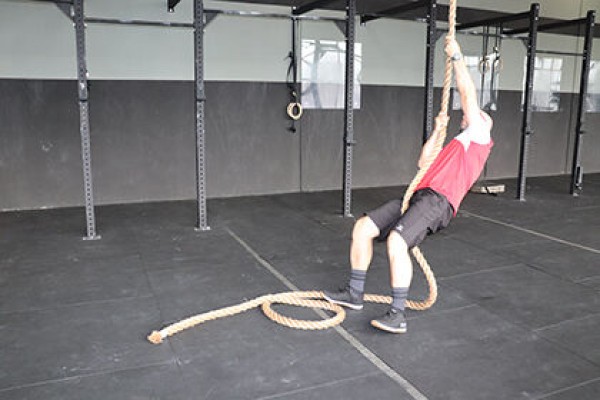
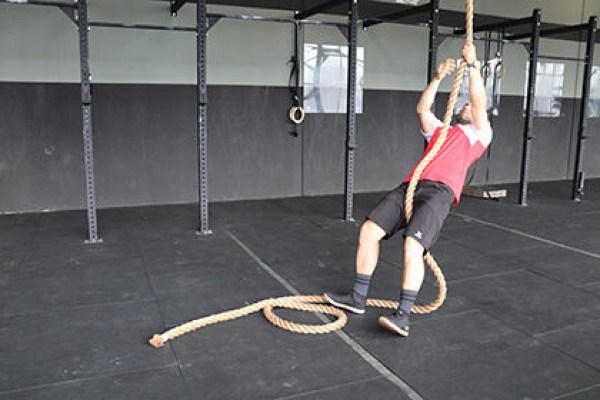
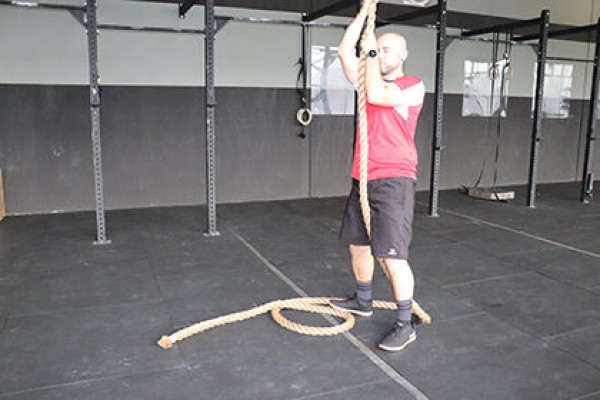
Sit on the floor with your legs stretched out and your upper body leaning slightly backwards, your outstretched arms in a raised position gripping the rope and preventing you from falling backwards (arms in front of your body, hands approximately at chest/leg height above your head). By moving one arm after the other upwards along the rope and alternately gripping the rope higher and higher, the body is continuously raised until the upright standing position is finally reached.
Attention:
The work is done with the arms (no support from the legs if possible).
Lighten:
The legs provide additional support when standing up.
Harden:
Additional weight (on the arms).
1 climbing rope
2 weight cuffs/1 weight waistcoat ► Make the exercise more difficult (additional weight)
Raising the upper body in prone position ► superman
Power
Individual work
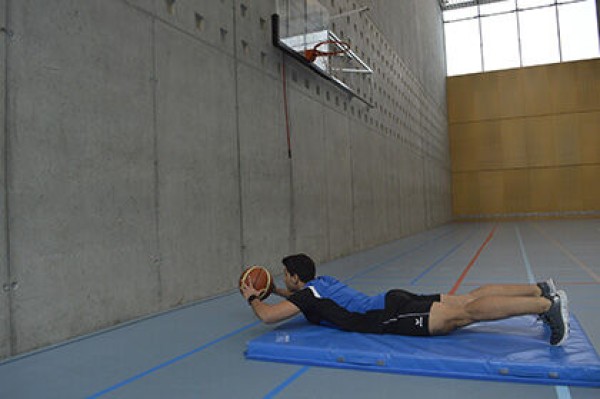
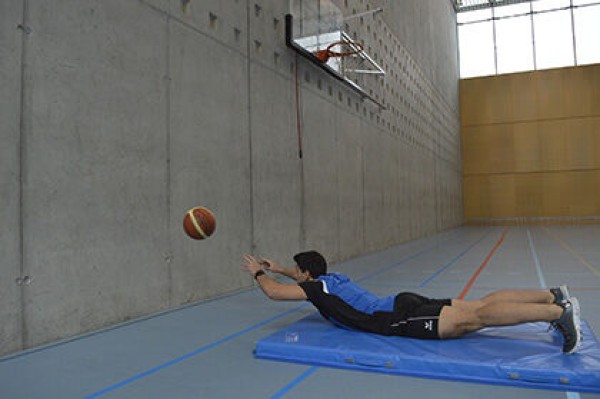
In a prone position approx. 1 metre in front of a wall, hold a ball in front of your head with your arms bent. Raise your upper body slightly and throw the ball against the wall with both arms (movement from the elbows, stretching the arms) and catch it again. The ball never touches the floor.
Attention:
Keep your upper body (incl. arms/elbows) raised at all times.
Lighten:
Just hold the position with your upper body slightly raised (without throwing the ball); hold your arms without the ball in front of you and bring them back sideways next to your body and back to the starting position.
Harden:
Additional weight.
Variant:
Hold a gymnastic stick in your hands with your upper body slightly raised (arms stretched), bring it to your chest (arms bent) and return to the starting position.
1 wall
1 soft mat (small)
1 ball (e.g. football, volleyball, basketball)
1 medicine ball ► Make the exercise more difficult (additional weight)
1 gymnastics stick/wooden stick ► Variation of the exercise
Raising the upper body in supine position
Power
Individual work
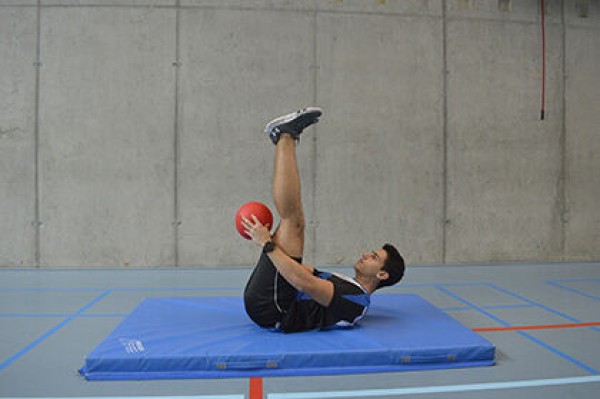
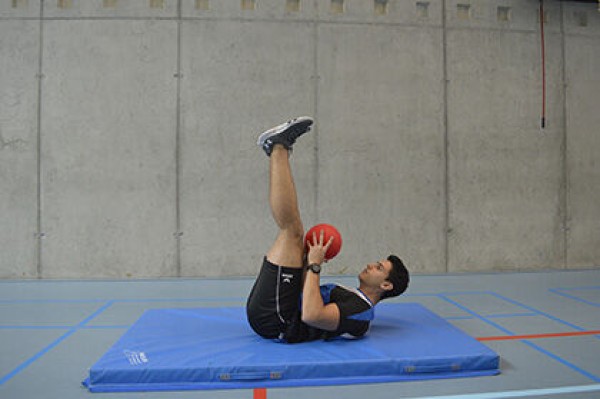
Lie on your back with both legs raised. Raise your upper body and circle a ball around your legs in this position (in both directions).
Attention:
Do not lower your shoulders completely (constant tension), head in a neutral position (no double chin).
Lighten:
Just hold the position with your upper body raised (without spinning a ball).
Harden:
Additional weight (heavy ball).
1 ball (e.g. football, volleyball, basketball)
1 medicine ball ► Make the exercise more difficult (additional weight)
Raising the upper body with outstretched arms in the seat (L-sit) ► L-sit
Power
Individual work

Sit on the floor with your legs straight, hands placed directly next to your hips and elbows pointing backwards, holding your body in a 90 degree position (upper body leaning slightly forwards) and pushing away from the floor with your arms stretched out straight (your entire body weight resting on your hands). Ideally, the toes should be pointed to ensure a straight line in the legs. The L-sit requires good arm and shoulder strength, but also good body tension and flexibility.
No material required
Lifting one arm in a push-up position alternating ► pillar bridge
Power
Individual work
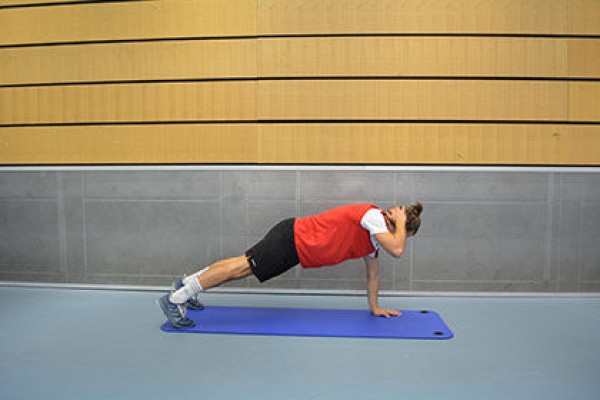
In the push-up position, alternate between raising one arm and bringing the hand next to the head/to the ear (same side of the body).
Attention:
Keep the torso stable and do not let it sag (actively tense the torso muscles).
Lighten:
Just hold the push-up position.
Harden:
Add weight (on the arms/on the back).
Variant I:
Combine the exercise with push-ups (i.e. lift the left arm and stretch it out). raise and extend your left arm, push-up, raise and extend your right arm, push-up, etc.).
Variant II:
Hold a dumbbell in both hands in the push-up position.
2 weight cuffs/1 weight vest/weight disc/sandbag ► Make the exercise more difficult (additional weight)
2 dumbbells ► Variation of the exercise
Lifting one arm in a push-up position alternating ► pillar bridge
Power
Individual work
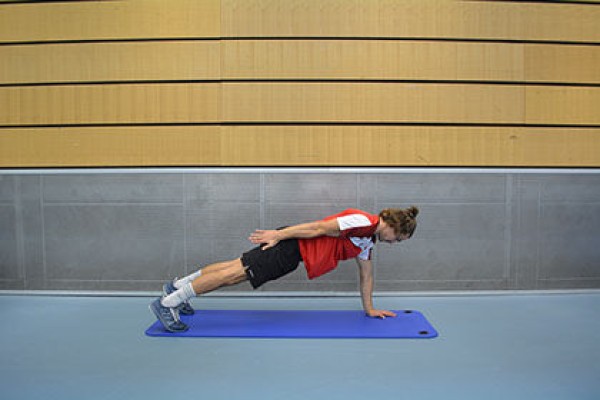
In the push-up position, alternate between raising one arm and bringing it to the hip/thigh (same side of the body).
Attention:
Keep the torso stable and don't let it sag (actively tense the torso muscles).
Lighten:
Only hold the push-up position.
Harden:
Additional weight (on the arms/back).
Variant I:
Combine exercise with push-ups (i.e. raise left arm and move to the side, push-up, raise right arm and move to the side, push-up, etc.).
Variant II:
Hold a dumbbell in both hands in the push-up position.
2 weight cuffs/1 weight vest/weight disc/sandbag ► Make the exercise more difficult (additional weight)
2 dumbbells ► Variation of the exercise
Raising one arm and leg crosswise in forearm support (left-right) ► pillar bridge / star plank
Power
Individual work
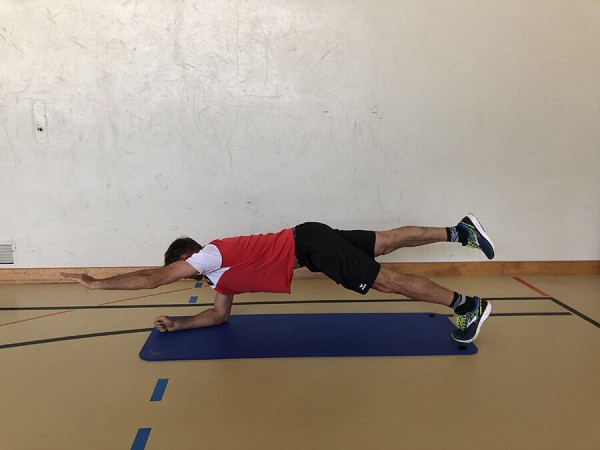
Underarm support, raise one arm (left) and one leg (right) crosswise and stretch out in the body extension, hold position.
Attention:
Head, torso, hips and knees form a line (do not stretch your buttocks upwards or let them sag, tense your stomach).
Lighten:
Place one knee (left) on the floor; hold the position in forearm support without lifting an arm or leg.
Harden:
Additional weight (on the back or on the arms/legs).
Variation:
Bring your elbow and knee together under your body, then stretch your arm and leg out again.
2-4 weight cuffs/1 weight vest/weight disc/sandbag ► Make the exercise more difficult (additional weight)
Raising one arm and leg crosswise in forearm support (right-left) ► pillar bridge / star plank
Power
Individual work

Underarm support, raise one arm (right) and one leg (left) crosswise and stretch out in the body extension, hold position.
Attention:
Head, torso, hips and knees form a line (do not stretch your buttocks upwards or let them sag, tense your stomach).
Lighten:
Place one knee (right) on the floor; hold the position in forearm support without lifting an arm or leg.
Harden:
Additional weight (on the back or on the arms/legs).
Variation:
Bring your elbow and knee together under your body, then stretch your arm and leg out again.
2-4 weight cuffs/1 weight vest/weight disc/sandbag ► Make the exercise more difficult (additional weight)
Raise one arm and leg crosswise in a push-up position (left-right)
Power
Individual work

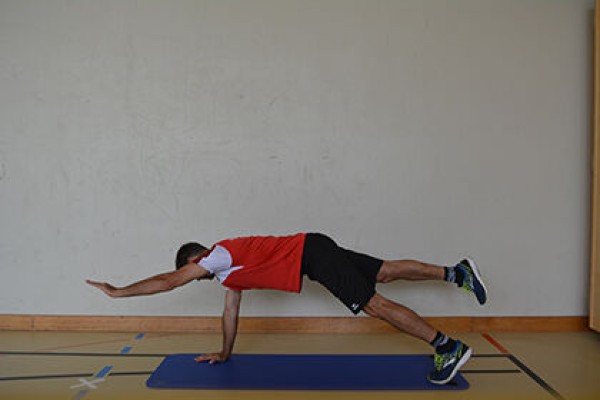
Lie down in the push-up position, raising one arm (left) and one leg (right) crosswise and stretching them out in the extension of the body, hold the position.
Attention:
Head, torso, hips and knees form a line (do not stretch your buttocks upwards or allow them to sag, tense your stomach).
Lighten:
Hold the position with raised arm and foot only briefly before returning to the push-up position.
Harden:
Additional weight (on the back or on the arms/legs).
Variant:
Bring the elbow and knee together under the body, then extend the arm and leg again.
2-4 weight cuffs/1 weight vest/weight disc/sandbag ► Make the exercise more difficult (additional weight)
Raise one arm and leg crosswise in a push-up position (right-left)
Power
Individual work
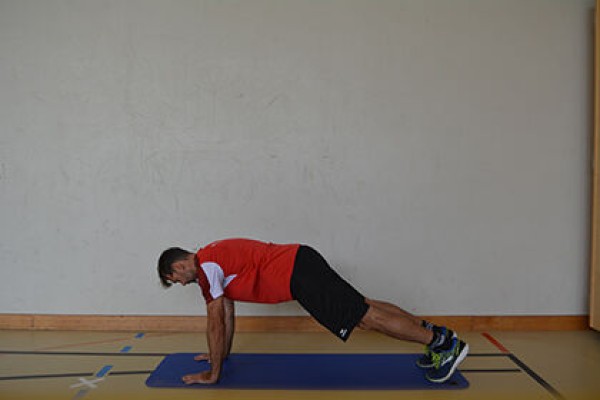
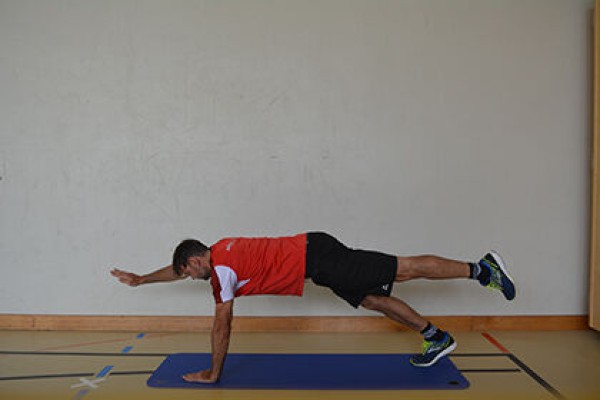
Lie down in the push-up position, raising one arm (right) and one leg (left) crosswise and stretching them out in the extension of the body, hold the position.
Attention:
Head, torso, hips and knees form a line (do not stretch your buttocks upwards or allow them to sag, tense your stomach).
Lighten:
Hold the position with raised arm and foot only briefly before returning to the push-up position.
Harden:
Additional weight (on the back or on the arms/legs).
Variant:
Bring the elbow and knee together under the body, then extend the arm and leg again.
2-4 weight cuffs/1 weight vest/weight disc/sandbag ► Make the exercise more difficult (additional weight)
Lifting one leg alternately in the seat
Power
Individual work
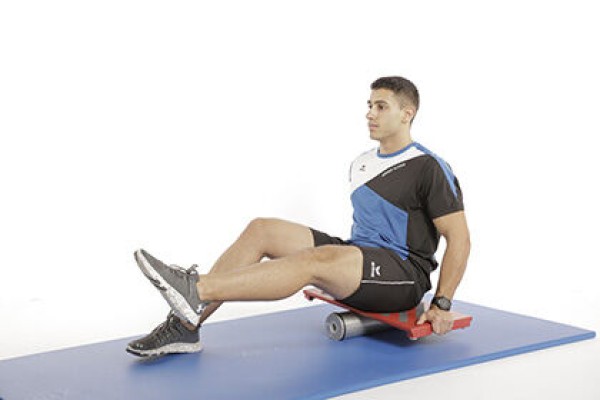
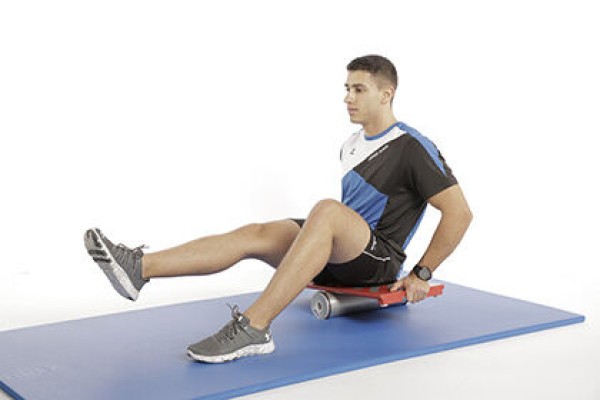
Sit on the balance board, place your feet on the floor and alternately stretch one leg forwards.
Attention:
Strong back.
Lighten:
Both feet placed on the floor (no stretching of the legs).
Harden:
Both legs lifted off the floor (bent and held up).
1 balance board incl. roller
Lifting one leg in forearm support alternately
Power
Individual work
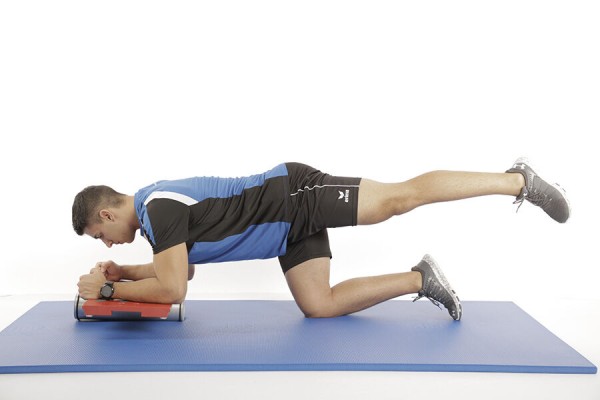
Underarm support on the balance board, with one leg stretched out in a high position (extension of the body) and the other leg bent (kneeling) on the floor. Balance and change the leg position regularly.
Attention:
Head, torso, hips and knees practically form a line (do not stretch your buttocks upwards or let them sag, tense your stomach).
Lighten:
Both legs bent on the floor (kneeling).
Harden:
Both legs stretched out in extension of the body (standing on the tips of the feet). Make it even more difficult by slightly lifting the legs alternately.
1 balance board incl. roller
Lifting an object
Power
Individual work
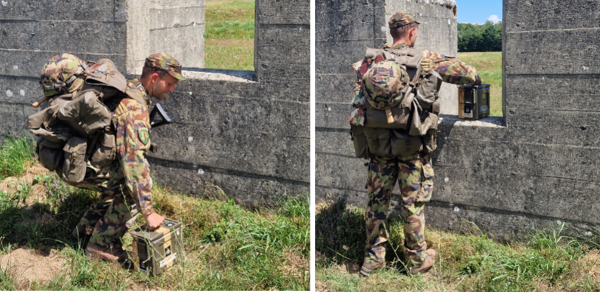
Lift one item of basic military equipment (approx. 10kg) onto an elevation and place it back on the ground.
Attention:
The back must be straight when lifting the load.
Lighten:
Equipment approx. 5kg
Harden:
Equipment approx. 15kg
Small wall/table
Weight 10kg
Weight 5kg ► Make the exercise easier
Weight 15kg ► Make the exercise more difficult
Lifting an object while standing
Power
Individual work
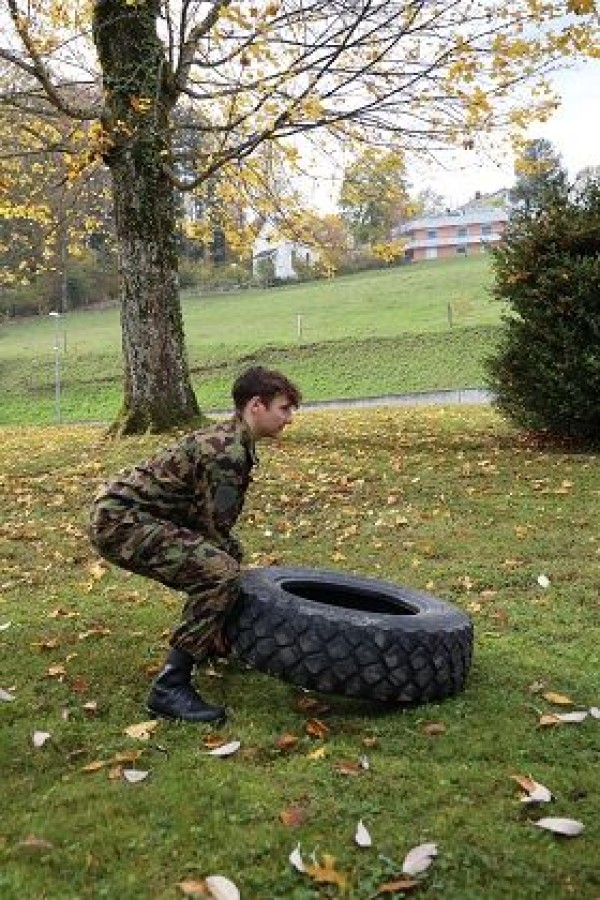
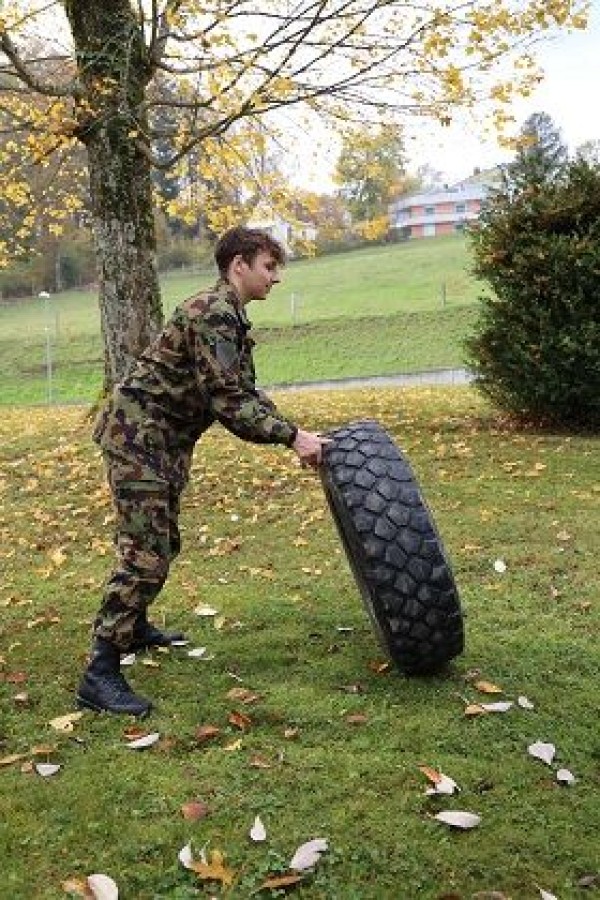

Grab the tyre lying on the floor with both hands and turn it to the other side.
Attention:
Keep your back straight, lift the weight out of your legs.
Lighten:
Less weight/load.
Harden:
More weight/greater load.
1 tyre (DURO)
1 tyre (PUCH) ► Make the exercise easier
1 tyre (10DM) ► Make the exercise more difficult
Raising and lowering the arms while standing
Power
Individual work

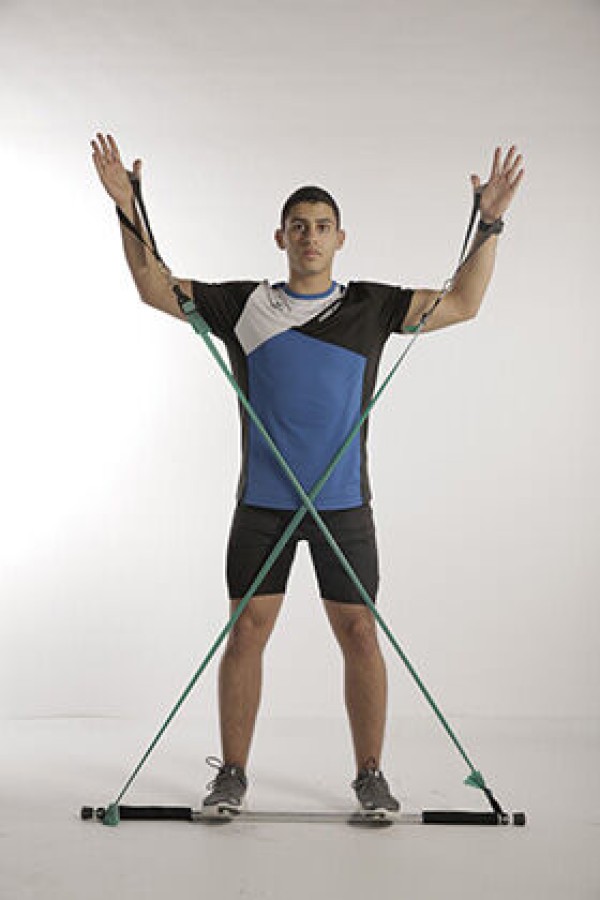
Stand shoulder-width apart on the gymnastics pole lying on the floor, upper body bent forwards, forearms bent, hands in the loops (thumbs pointing upwards), with the elastic bands crossed, move the arms sideways backwards and upwards (elbows at shoulder height, arms pointing diagonally upwards, shoulder blades close together) and back to the starting position.
Attention:
Keep your back straight and stable throughout the exercise (tense your core).
Lighten:
Select less strong elastic bands.
Harden:
Choose stronger elastic bands.
Variant:
Perform the exercise sitting upright, bend your legs slightly and hold the pole in place with your feet up.
1 gymnastic bar with elasticated straps
Raising and lowering the arms while standing
Power
Individual work
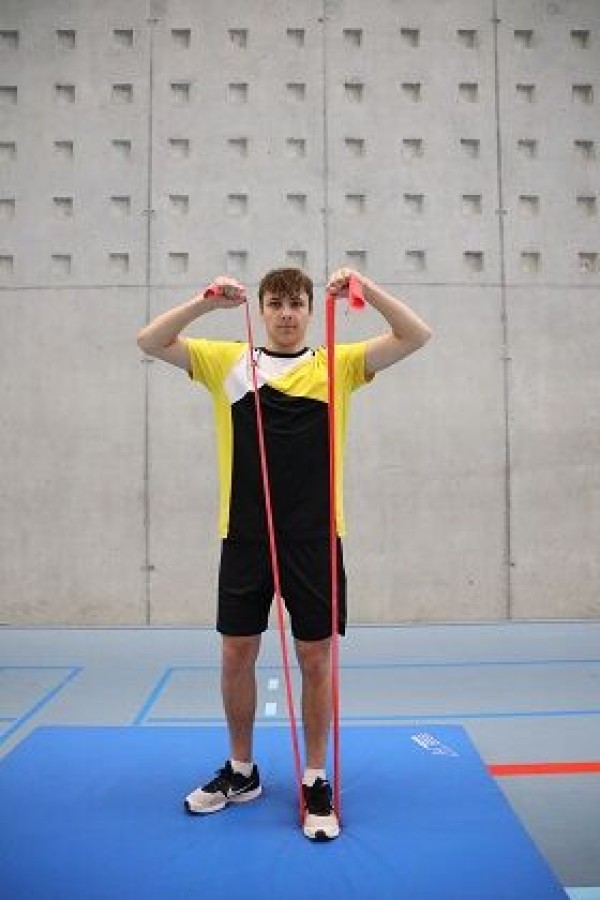

Step, step onto the centre of the elastic band with your front foot, hold one end of the elastic band at hip height with your arms slightly bent (hands shoulder-width apart or together), raise your arms (elbows at shoulder height, hands approximately at face height) and lower them back to the starting position without changing the angle in the elbow joint.
Attention:
The movement only takes place in the shoulder joint (do not raise your shoulders), no hollow back (tighten your stomach).
Lighten:
Choose an elastic band with less resistance.
Harden:
Choose an elastic band with greater resistance.
1 elasticated rubber band
Raising and lowering the arms while standing ► battle rope
Power
Individual work


Stand shoulder-width apart, knees slightly bent, grasp one end of the rope with each hand (rope end facing the body), move your arms up and down at the same time.
Attention:
The more beautifully the rope swings, the better/cleaner the exercise is performed.
Tighten your stomach, fix your shoulders (push towards your hips).
Lighten:
Lower cadence/lower range of motion.
Harden:
Higher cadence/larger range of motion; perform the exercise standing on one leg or in a lunge (front leg at a right angle, knee not overhanging the tip of the foot, knee of the back leg almost on the floor). When performing the exercises in the one-legged stance or lunge, also change the standing leg.
Variant:
Integrate lunges on the left and right side, perform the exercise in a squat, squatting and kneeling position.
1 rope/rope
1 (lantern) pole/tree
Raising and lowering the arms while standing ► front raise
Power
Individual work
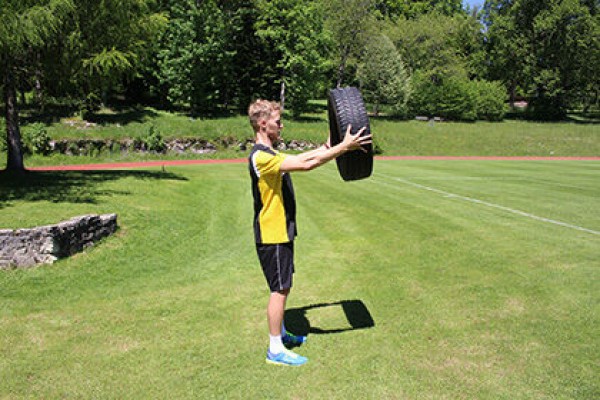

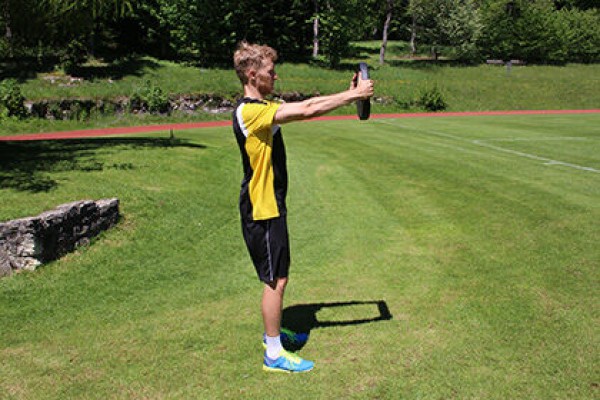
Stand upright, hold an object (e.g. tyre or rucksack) in front of your body at chest height with your arms almost outstretched, lower and raise your arms (front lift).
Attention:
Tense your stomach, straight back, slightly bent knees.
Lighten:
Less weight/load; raise your arms less.
Harden:
More weight/greater load.
1 tyre (PUCH)/fighting rucksack/weight disc
1-2 PET bottles/1 helmet ► Make the exercise easier
1 sandbag ► Make the exercise more difficult (additional weight)
Raising and lowering the arms while standing ► front raise
Power
Individual work

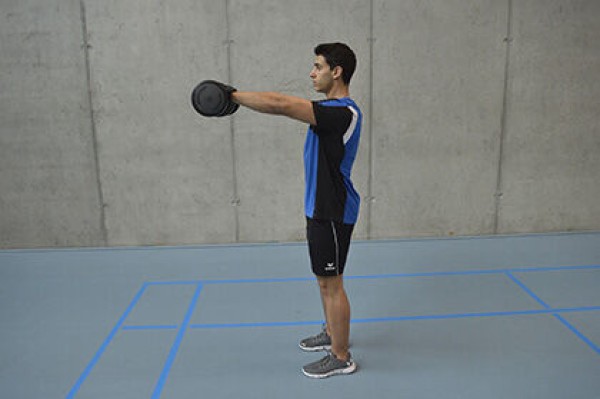
Stand upright, arms extended downwards in front of the body with the dumbbells (or kettlebells) in your hands (hanging), the backs of your hands pointing forwards (overhand grip), raise your arms in the direction you are facing until they are horizontal (shoulder height, backs of hands pointing upwards) and lower them back to the starting position (front lift).
Attention:
Keep your back straight (possibly back against a wall), actively tense your core.
Lighten:
Less weight.
Harden:
More weight.
2 dumbbells/kettlebells
Raising and lowering the arms while standing ► swing
Power
Individual work
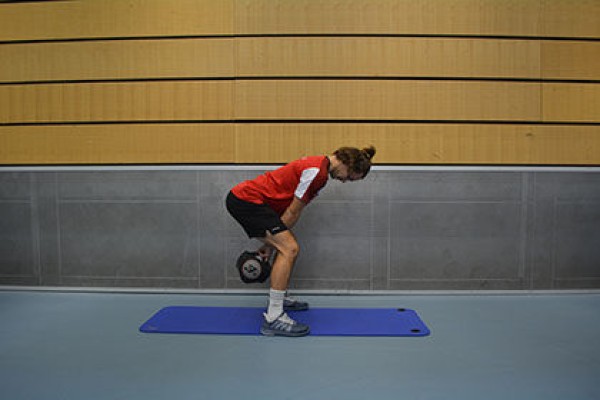

Stand upright, feet hip-width apart, knees slightly bent. With your back straight and your knees still slightly bent, grasp the weight in front of you. As you pick up the weight, swing it backwards through your spread legs until your forearms lightly touch your hips and then push your forearms forwards with your hips. It is important that the weight moves upwards with the swing of the pelvis (perform the movement slightly at the beginning/swing the ball forwards just a little, and as soon as you have memorised the movement, swing the weight a little further upwards).
Attention:
A hunched back is a bad posture. The weight moves upwards through the hip movement and not by raising the arms (loose shoulders, curl the shoulder girdle). The knees do not move forwards and the feet remain on the floor for the necessary stability (no standing on tiptoe).
Lighten:
Less weight.
Heavy:
Move the weight up to the height of the face. More weight.
Variant:
Hold the weight with one hand (train both sides = organisation requires twice the time).
1 sandbag/fighting backpack/kettlebell
Alternating raising and lowering of the arms while standing
Power
Individual work
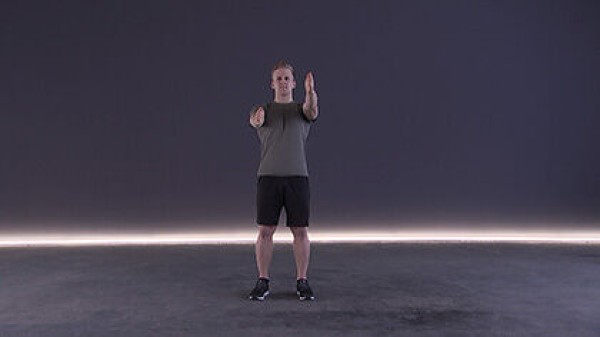

Stand upright with your shoulders shoulder-width apart, arms stretched out in front of you, move your arms up and down in a staggered manner (crown and navel height).
Attention:
Always keep your arms almost fully extended and never lower than navel height.
Lighten:
Stretch your arms less/bend them slightly.
Harden:
Hold additional weight on your arms or in your hands.
2 weight cuffs/weight balls/dumbbells ► Make the exercise more difficult (additional weight)